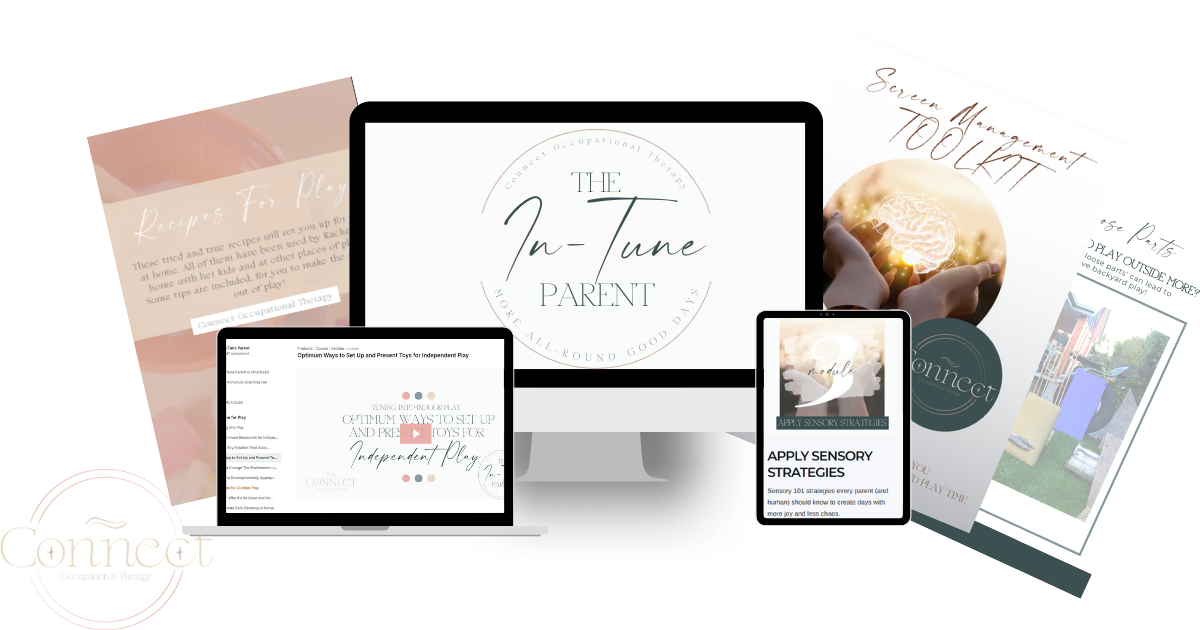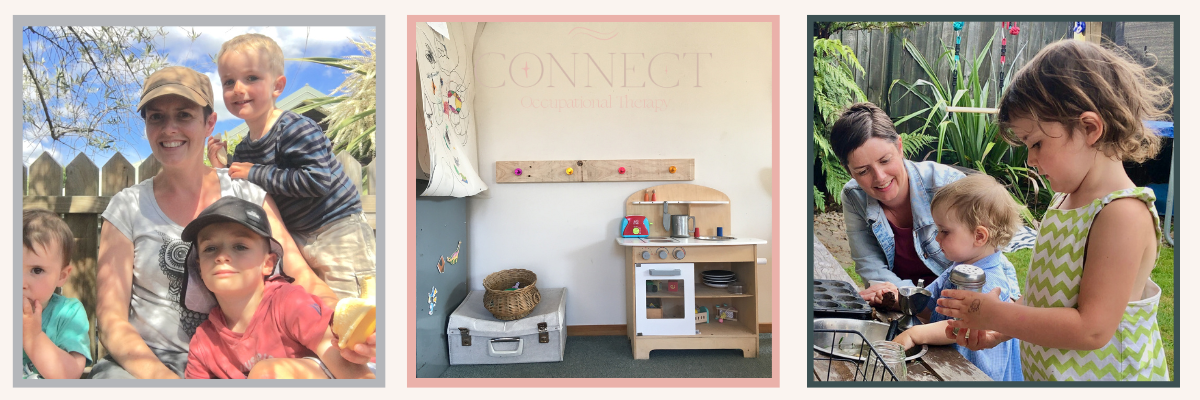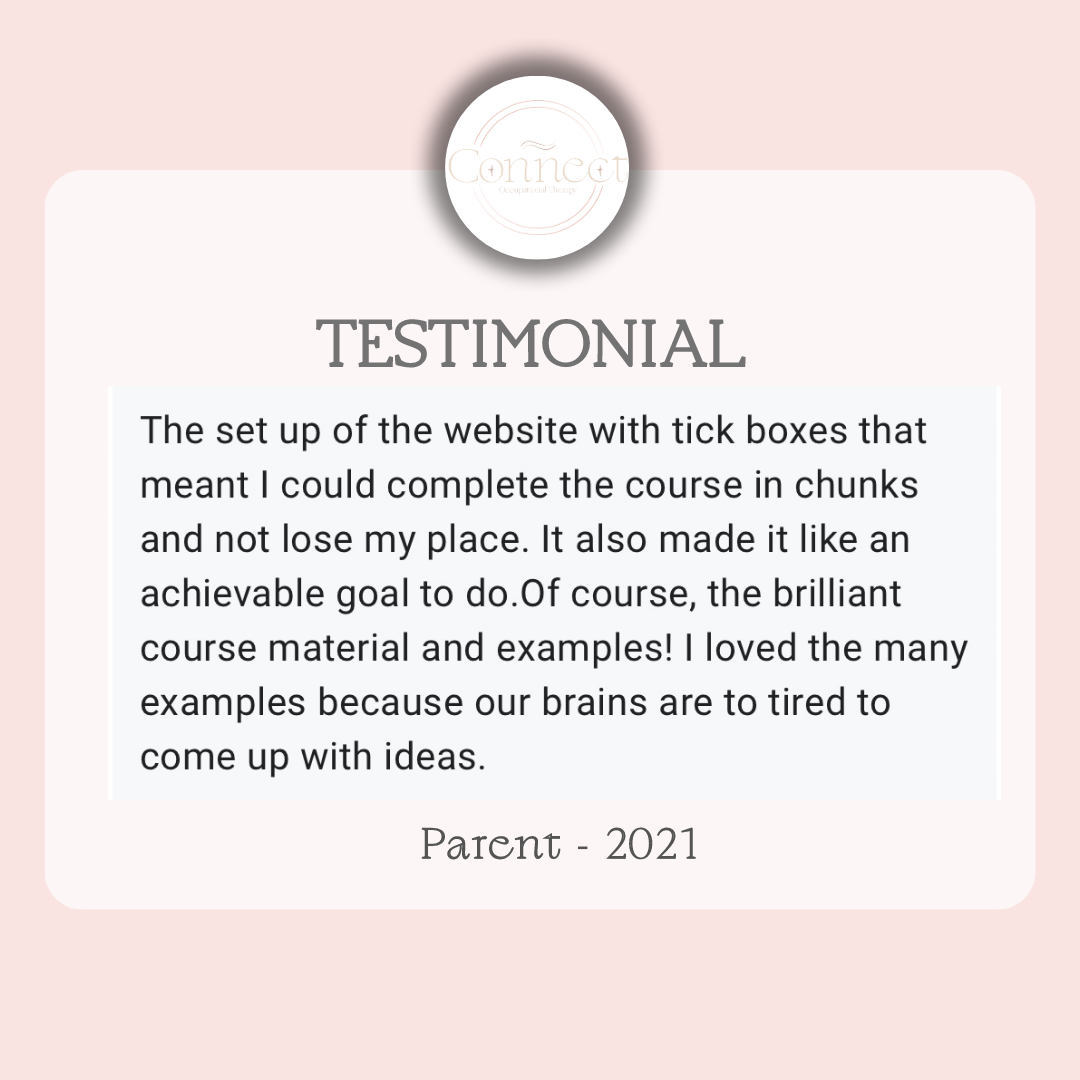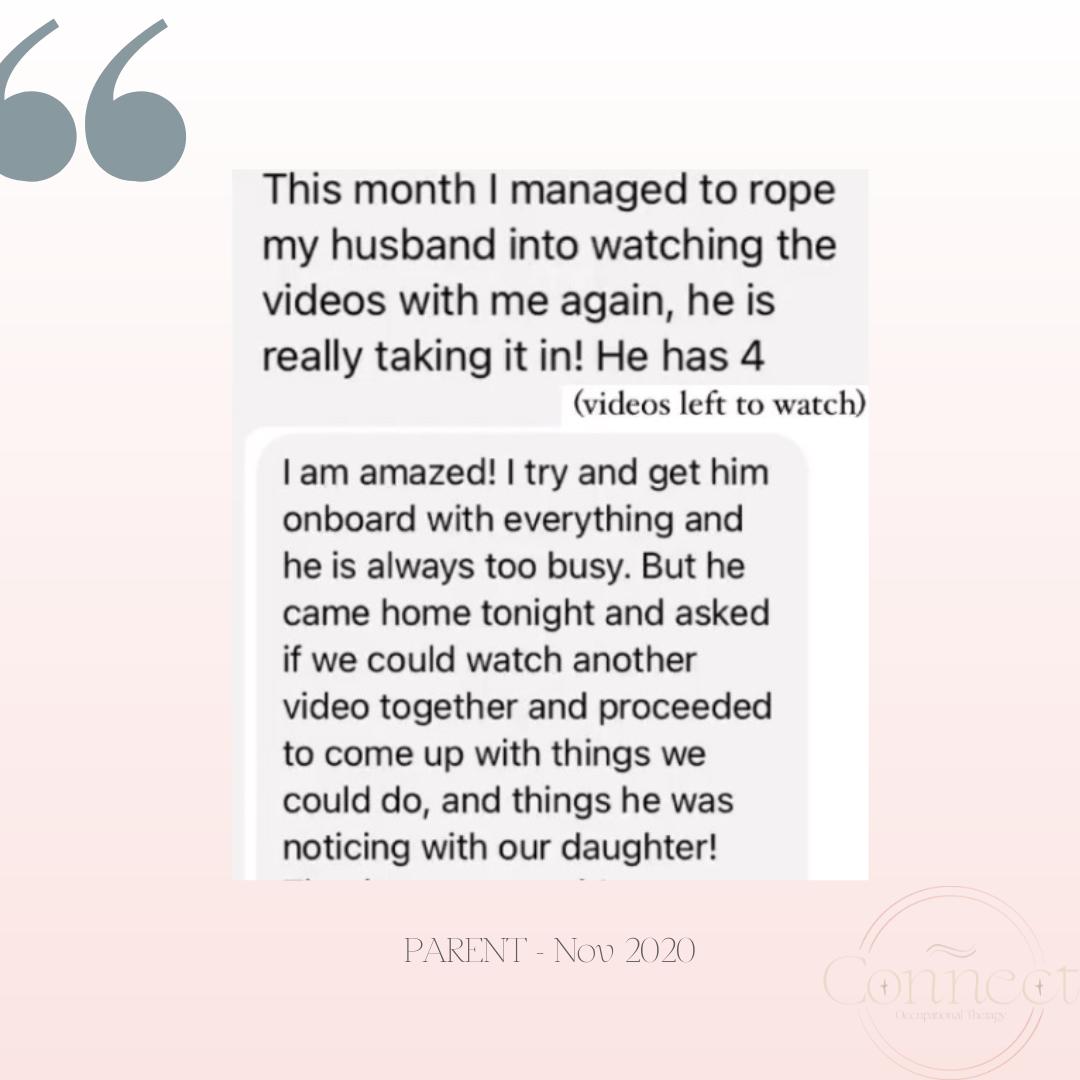Parenting and Nervous System Regulation with Connect Occupational Therapy
Parenting doesn't come with a manual... or does it?
That saying "parenting doesn't come with a manual" is indeed true... and yes, each child and family and environment are unique and individual.
BUT.
How about you let The In-Tune Parent become your parenting manual?
Where else are you going to find a comprehensive parenting course that can help you:
Achieve a balance of screen time with play time
Apply sensory techniques to help you and your kids become more regulated through the day
Cope with your kids' meltdowns in a trauma-informed, responsive way
Know exactly WHAT to do and HOW to do it, to get your kids playing independently
Extend on your kids' play (so you can get an extra few minutes of peace!)
Run your household smoother with schedules and other tools that you can print and use straight away
Embrace nature play more easily, with less frustration
Parent according to your menstrual cycle
Does that sound like a parenting manual to you?
Because it kinda does to me....
When I designed The In-Tune Parent, I designed it as the most comprehensive, yet easy to implement resource I could ever imagine, for parenting kids aged 2 - 8 years.
The content in The In-Tune Parent course is a blend of my unique combination of:
10 years of parenting
my practice as a paediatric occupational therapist (where I examine the environmental, personal, and contextual barriers that exist, to help kids and families play - it's literally my job description)
my passion for making complex info easy to understand (all of the "sensory processing" info)
my background as a mental health provider
CLICK HERE TO SEE THE COURSE CONTENT
I know parents. Like, I know parents.
I talk to hundreds of parents through my Instagram account.
I know your challenges. I've lived some of them myself.
And that's why The In-Tune Parent has:
Lifetime access (dip back in when your family changes, you move house etc)
Short, simple videos (watch on 1.5x speed when you're doing other things!)
A downloadable screen management toolkit, which has easy to use schedules and scripts to use to extend play
Why not embrace The In-Tune Parent as your parenting manual, starting today?
USE THE CODE 25OFF TO SAVE $100
Code expires midnight Sunday 24 Sept
All the best,
Rachel
Connect Occupational Therapy
Is Our Parenting Course for You?
You many have seen our parenting course The In-Tune Parent, and wondered if it's for you.
So, here's a list to help you decide...

The In-Tune Parent programme is for you if:
➡️ you have had your first child and are past the “baby” stage but are wondering how to parent a preschooler
➡️ are sick of trying to entertain your kid with random activities (that take longer to set up than they play with them for!)
➡️ have a blank slate of a backyard with kids who aren’t willing to play outside
➡️ have no idea on how to get your kids playing
➡️ have ended up relying heavily on screens to get through the day, but this isn’t sitting right with you and you want a better balance
➡️ have had your second child (or are pregnant) and want to set yourself and your house up well for the next 6 years of parenting
➡️ are a parent who invested in antenatal education before you had your baby, and now you want to further add to your parenting toolbox for the next stages of parenting
➡️ have kids that are sensory seekers/always moving, and you want to learn more about the sensory systems to help them
➡️ have a child in occupational therapy and you want to access parent education (this course) to supplement that
➡️ suspect your child would benefit from occupational therapy but you are on the waitlist for public/can’t access private due to funds/want to supplement your knowledge
➡️ are an early childhood educator/home based educator who wants to up-skill
We love supporting parents to access good quality, developmentally appropriate ways to play and learn.
The In-Tune Parent has helped many parents be able to unlock play for their kids, and implement a sensory lifestyle at home so the whole family feels better regulated each day.
To read other parent's testimonials and check out the course content, CLICK HERE.
And if this list sounds like you, ENROL TODAY.
All the best,
Rachel
Connect Occupational Therapy
“Co-occupations”; The Joy of “Doing With”
A while ago, on an evening after dinner, I took my two girls for a bike ride. They are 3 and 6, and they were snugly squished into the bike trailer attached to my bike.
As I speedily traversed the cycle lanes in our neighbourhood, I thought a lot about the fact that biking together has to be one of my absolute favourite “co-occupations”.
A “co-occupation” is simply an activity that is “done with”. One that promotes emotional, physical, and responsive attachment.
And parenting is absolutely chocka-block with “co-occupations”.
For a new parent, co-occupations might look like:
Feeding
Rocking your baby to sleep
Babywearing
Changing diapers
And then as your child grows, they might look a bit more like:
Adventuring together
Gardening together
Playing with a ball together
A co-occupation is essentially something you do together, that you both feel good about.
I started biking with my kids more regularly in the lockdowns.
And I found it SUCH an enjoyable activity. I don’t have a flash bike, it’s about 15 years old from The Warehouse and it’s got rust specks and the tyres go flat more often than they should.
But, it’s enough to give me a sense of freedom.
And that sense of freedom is the essence of why cycling is such a cup-filling co-occupation for me and my kids.
When I go with my big boys, we go really fast and race each other (they win).
-
When we go as a family, we notice things in our neighbourhood together. We communicate with each other in a different way, and we experience a different sort of freedom that we don’t when we are pushing the buggy on a family walk.
Textbook definition – co-occupations occur when people perform an occupation in a mutually responsive, physical and emotional interconnected manner.
What "co-occupations" do you enjoy with your whanau? Can you identify them? Can you seek them out?
For further guidance to find your co-occupations and develop a sensory lifestyle together as a family, see our online course The In-Tune Parent.
Available for you to work your way through at your own pace, this course helps Maxed-Out Mama's of 2 - 8 year olds make key shifts to bring in more independent play, joy, and regulation for the whole household.
CHECK IT OUT HERE

The Three Different States of The Nervous System
Have you ever felt like you're more constantly in fight/flight than you should be?
Or, maybe you feel "stuck", like you can't move on from situations... you feel a lack of hope and it's SO hard to get going.
When we look to Polyvagal Theory (Dr Stephen Porges, Deb Dana), it tells us that these two states are related to the biology of the nervous system.
Polyvagal Theory tells us that there are three different states that the nervous system can be in.
The states can be likened to moving up and down a ladder.
At the bottom, we have the "stuck" state. It's a feeling of disconnection, of loneliness. The Nervous System is in a state of protection. Except it's doing it's job so well, that the body doesn't want to engage with the world around us anymore!
And in the middle is the "sympathetic activation" state. It's pretty well known - our bodies sense danger and the world feels overstimulating. It's an "action" state - BOOM! You're in "get things done" mode.
Then at the top of the ladder is our state of connection. A good way to describe this state is being in flow. We feel like we can and want to connect with others. Our bodies have an internal sense of safety. We can tune out irrelevent sensory stimuli, so we can remain regulated and engaged in the moment.

Being at the top of the ladder sounds pretty good, right?
But here's the thing.
We don't expect the human experience to ALWAYS be hanging out at the top of the ladder! No! That's not achievable. It's perfectly normal (and expected!) to move up and down the ladder.
BUT. What we don't want is to be REMAINING in the middle or bottom states.
Or dropping down into them too frequently during our days.
A sign of a healthy nervous system is being able to shift between all three states easily.
If you're finding that you're:
struggling to experience feelings of connectedness, joy, or "flow"
overreacting frequently to small things in your day
wanting to hide away and not be present with others
having feeling of feeling on edge, triggered by noise, overstimulated often
All of these things can indicate that you're struggling to remain at the top of the ladder.
The Safe and Sound Protocol is designed to help people "shift" up and down the nervous system ladder more easily.
Meaning you have more capacity and can stay at the top of the ladder more often.
Get in touch with us today to find out how you can get started.
Rachel
How Do You Know When It's Time To Seek Support?
If you're a sensory sensitive parent, a Mum in the postpartum phase, or perhaps a neurodivergent parent, then you might just be wondering...
"When exactly should I seek help from an occupational therapist?"
The answer is ultimately up to factors like your capacity, your access to either private or public health services, your trust and relationship with a therapist etc.
But if you are thinking about seeing an occupational therapist, the main thing that might indicate you could benefit is that:
Your condition is impacting on the things you WANT or NEED to do in your daily life.
-
Notice the emphasis on the WANT and NEED:
This is to draw your attention to them. This might look different for everyone, for example: what a 33 year old parent WANTS or NEEDS to do in their daily life (e.g. sharing dinner duties, attend playgroups, start back at paid work, play with the kids, manage the household, grocery shop, organise the house, delegate the mental load, recover your identity.... etc. etc.) might look quite different to what a young single 22 year old builder WANTS or NEEDS to do in their daily life.
-
I've used the word "condition":
This might not be a "diagnosed" condition. Some of the clients I see for nervous system regulation do have diagnosed conditions such as long covid or depression. But, some don't. (The reason for this is that maybe they haven't sought formal diagnosis yet, or don't feel they need to, but I'm also seeing a lot of women who fall into the gap of discovering their own neurodivergency and aren't yet diagnosed).
Your "condition" might be diagnosed, but maybe it's something along the lines of having a narrow window of tolerance, long term stress, the ongoing impact of holding the mental and physical load of being the default parent, your auditory sensitivity, or your touch sensitivity.

If you notice that you are:
sensitive to noise
avoiding loud gatherings/places
triggered by your children's noise
hiding away to avoid your children
struggling to experience any joy or playfulness in parenting
prone to snapping or flipping your lid often
finding it hard to relax
finding it difficult to get into a state of "flow" in life activities
overstimulated often
And you are finding that the above symptoms are making it more difficult for you to do the things you NEED or WANT to do in your role as a parent, then it might be time to seek some professional support.
Connect Occupational Therapy's packages are designed to offer you support so you can feel and do your best in your parenting role.

BASIC PACKAGE - This is for you if you want insight into your sensory nervous system, and you feel confident in your own ability to implement changes independently.
STANDARD PACKAGE - This is ideal for you if you want insight into your sensory nervous system, PLUS the ability to text/email afterwards to consult about changes you're making as a result of our assessment and recommendations.
SAFE AND SOUND PACKAGE - You are guided through a research based listening programme that helps you "reset" the nervous system. Together we get your nervous system out of "stuck" mode. You will be able to continue with your roles in life feeling more grounded, calm, less stressed or irritable.
We specialise in helping tired, overstimulated parents, just like you. You don't have to do this alone.
Book a free 15min call to see if we're right for you.
Rachel
Resources informing this blog post:
"Sensory Health" - What Is it and Why Does It Matter?

Lately I've been sharing more about "sensory health".
Why?
Well, because "sensory" is the basis of being human, and I truly think that it's too often overlooked when considering mental health.
I started my career as an OT working in people's homes, supporting them with major depressive disorder, schizophrenia, and bipolar disorder. Some of these individuals were neurodivergent as well.
So you can imagine that yes, of course I consider a mental health lens when I'm working with mothers. I look at how engaged they are in their communities, what their "affect" (facial expression) is like, what their daily/weekly routines are like, how they are being supported (or not) to share the load, how easy they're finding it to share information, how we form a therapeutic relationship.
And (most importantly), I listen to them when they tell me over overstimulated they are and how this affects their ability to do the things they need to do or want to do in their roles as mothers (such as, cook dinner easily, go to playgroups, play with their kids etc).
Heartbreakingly, I frequently have Mums breaking down into tears with me on discovery calls. Yes, these are 15 minute calls (often more like 30mins) intended to be a "are we the right fit", but for many of these Mums, they just.feel.so.unseen.
Sometimes, it's often the first time that they've had someone validate their situation for them.
The struggle.
The place that they're in; holding the space for their children.
Sometimes putting their hopes and dreams on hold.
Trying to piece together their identity as mothers.
Trying to cook the dinner.
Trying to re-parent themselves.
Trying not to lose their cool at their toddlers and preschoolers.
Some of these Mums have been diagnosed with ADHD. Some not. Some with anxiety or depression. Some not. Some are waiting for ADHD assessment. Some not.
But what's in common with all of these Mums, is that addressing sensory health is quite possibly a missing piece.
Sensory health is the bridge that connects being able to integrate our senses, self-regulation, and well-being.
(Cavaliere, C.M. PhD, OTR, 2021).
For example:
When we feel anxious, we can use sensory strategies to ground us and help us think more clearly.
When we're depressed, we can use sensory strategies to alert us and support our nervous system back to a place of feeling connected, motivated, and social.
Are you being supported with your sensory health?
Our services here at Connect Occupational Therapy are designed to help you address your sensory health, so that you can feel and do your best.
In our In-Tune Parent course, you'll find a whole section about the senses, recognising triggers, and applying sensory strategies. These strategies can work for both yourself and your children.
With our Safe and Sound Protocol, we can offer you individual support to regulate your nervous system through the vagus nerve, helping you to reduce your sensitivity to noise and widen your window of tolerance, so you can move out of fight/flight/stuck modes and cope better with the demands of parenting.
Book a discovery call to find out more today.
(And don't worry, we hold space for you if you end up shedding a few unexpected tears).
Best,
Rachel
Connect Occupational Therapy
Nurturing the Nervous System: The Benefits of the Safe and Sound Protocol for Mothers
Motherhood is a remarkable journey, but it can also be an emotionally intense and challenging experience.
As mothers, we strive to provide our children with the best care and support possible. However, in the process, we often find it hard to prioritize our own well-being. The demands of modern motherhood can often leave us feeling overwhelmed, stressed, and disconnected from ourselves.
The Safe and Sound Protocol (SSP) is a groundbreaking intervention that can help mothers regulate their nervous system, reduce stress, and enhance overall emotional well-being. In this blog post, we will explore the benefits of The Safe and Sound Protocol for mothers.
Understanding the Safe and Sound Protocol (SSP):
Developed by Dr. Stephen Porges, the SSP is a non-invasive, auditory intervention designed to promote regulation by stimulating the vagus nerve. The vagus nerve plays a crucial role in our autonomic nervous system.
The autonomic nervous system controls involuntary bodily functions, including heart rate, digestion, and stress responses.
The SSP aims to improve the vagal tone. Which in turn, can help the body's ability to self-regulate emotions and stress.
How the Safe and Sound Protocol Works:
The Safe and Sound Protocol involves listening to specifically filtered and modulated music that targets the middle ear muscles. This auditory stimulation triggers a physiological response that supports the nervous system's ability to regulate stress and arousal. The SSP delivered at a pace that suits the individuals' nervous system. This means that some people may only listen for a few minutes each day, and others up to 20 minutes per day, until they complete the total five hours.
Benefits of the Safe and Sound Protocol for Mothers:
-
Stress Reduction:
Motherhood can be emotionally taxing, and stress is an inevitable part of the journey. The SSP helps mothers lower their stress levels by enhancing the parasympathetic nervous system's functioning, promoting a state of relaxation and calm.
-
Emotional Regulation:
The SSP supports emotional regulation by improving vagal tone. As mothers, we often experience a wide range of emotions, and having a regulated nervous system helps us respond to these emotions in a more balanced and controlled manner.
-
Increased Resilience:
By promoting regulation, The SSP can help mothers build resilience in the face of life's challenges. It equips us with the tools to bounce back from stressful situations more effectively.
-
Enhanced Bonding with Children:
When mothers are in a state of emotional balance, it can help build positive interactions with their children. The SSP may improve the mother-child bond, fostering a deeper sense of connection and understanding.
-
Improved Sleep Quality:
Many mothers struggle with sleep disruptions due to the demands of parenting. The SSP's calming effects can lead to better sleep quality, leaving mothers feeling more rested and energized.
-
Self-Care and Empowerment:
Going through The SSP is an act of self-care, sending a powerful message to yourself that your well-being matters. It can help you to empower yourself to take an active role in your mental and emotional health.
-
Reduced Anxiety and Overwhelm:
The SSP may help you alleviate feelings of anxiety and overwhelm that arise from the challenges of parenting and other life stressors.
The Safe and Sound Protocol offers an opportunity for the modern-day parent to prioritize mental health and rediscover emotional balance.
By improving regulation and reducing stress, The SSP can help busy Mums face the challenges of motherhood with more resilience, patience, and joy. Taking the time to invest in yourself through The SSP is not only an act of self-care, but also a gift to our families, as it allows us to show up as our best selves in nurturing and supporting our children.
Book a call HERE to find out more how you can get started with The SSP today.

Connect Occupational Therapy Blog
Welcome to the Connect Occupational Therapy blog, breathing positive energy into weary people and families by taking a sensory based approach to life.
If you would like to access our services, please use the relevant tab on the menu bar.
Our current ways to support you are:
The In-Tune Parent: a comprehensive parenting course for parents of 2-8 year olds
The Safe and Sound Protocol: 1:1 nervous system regulation for Mothers
Pick My Brain sessions (suitable for short problem-solving sessions with parents, or questions from therapists about practice)
In-person paediatric occupational therapy for 2-10 year olds
We also offer a range of free and low cost parenting resources, including educational content on instagram, downloads about backyard play, managing life with a baby and older kids, sensory processing, managing screen time, and parenting to your menstrual cycle.
We look forward to hearing from you soon.
Rachel
Connect Occupational Therapy



